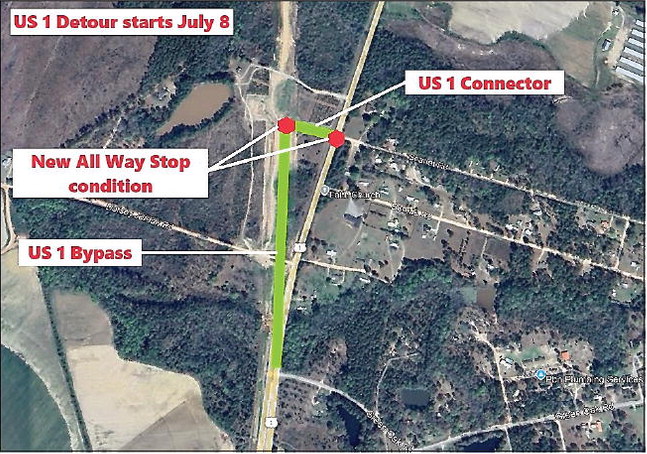continued from page management zones ….
continued from page
management zones to protect all state waters within the project limits,” the news release stated. Those interested in following the project progress were invited to visit https://t007616-vidalia- gdot.hub.arcgis.com/.
The railroad line targeted for clean up was previously owned by Central of Georgia Railroad Company, which was issued a certificate and decision from the Interstate Commerce Commission to abandon and discontinue service along the section of the railroad between the City of Vidalia and the community of Hester in 1983. In July 2004, GDOT acquired this section of railroad from Central of Georgia Railroad Company in the interest of preserving the railroad corridor for possible future use, according to a statement from GDOT. Since that time, there has been no rail service along this section of rail and the corridor is overgrown with thick vegetation and the tracks have fallen into a state of disrepair, the GDOT statement points out.
The cleanup project in Toombs County is expected to commence this summer and this “initial phase” is anticipated to be completed in the fall. The old line actually extends through Montgomery County and into Jeff Davis County, culminating at Hazlehurst, the home of Beasley Timber Company, which is one of the largest lumber processing sites in North America. With federal focus on strengthening the country’s infrastructure and lessening the carbon footprint of hauling products on highways by trucks, there is a renewed emphasis on utilizing the country’s railways as a safer and more environmentally sound alternative. Portions of rail lines surrounding Vidalia have already been rehabilitated per the state’s long-range plan for upgrading rail services. (See sidebar article, GDOT State Rail Plan).
GDOT’s “Railroad Rehabilitation, Vidalia to Hester” (project #T007616) has focused new attention on the old railroad line which roughly parallels Georgia Highway 130 (Adams Street) then turns right and toward Amberwood, an established neighborhood inside Vidalia’s city limits. Remnants of the old railroad track, which once crossed Highway 280 via an overpass, can still be seen in downtown Vidalia and in the countryside.
In the years since service on the line was abandoned, parts of the track have been pulled up and paved over and homes have been built next to the old line. What concerns Betty and Phil Moxley and their neighbors, who own homes on Brenda Lane in Amberwood, is what comes next? “I love trains, but I don’t want one running through my backyard,” said Betty, whose father and grandfather worked for the railroad.
This is not the first time Amberwood residents have raised questions about the old rail line. In 1997, a proposal to use the railroad bed for a “Rails to Trails” recreation site encountered fierce opposition from Amberwood residents and was abandoned. Retired Vidalia attorney Charles Andrew was one of the proponents of creating a greenspace on top of the old railroad bed that ran through Amberwood Subdivision. “The federal government was encouraging taking abandoned railroad tracks to make green spaces.” The local proposal was to tie Vidalia into a regionwide “Rails to Trails” project offering hundreds of miles of scenic trails for hiking, jogging and biking. “We had a huge effort. Everybody from Augusta to Jacksonville, Florida, wanted it,” Andrew said, noting that about 80 Amberwood residents started a grassroots movement to protest the proposal. They feared bringing a recreational corridor into their community would not only invade their privacy, but also invite crime. Local leaders responded by calling a halt to the project. The idea was scrapped and never to be revisited.
“It just died on the vine. That was the greatest disappointment of my civic career,” Andrew said. “I think it could have been the single best historical and environment benefit to Vidalia, as important as the Vidalia onion.”
Betty Moxley said she is fully aware of the old railway line since it is included in the plat for her property and is an obvious part of the landscape. “We knew the state owned the old railroad,” she acknowledged. Moxley’s home is one of four houses on a cul-de-sac on Brenda Lane. Three of the homes back up to the old railroad line, including the Moxley home. Through the years, Betty and Phil have tried to keep the area between their property and the railway cleared of debris and vegetation for appearance and safety purposes. The Moxleys had heard nothing new about the old railway line for the 15 years they have lived in Amberwood Subdivision until last week.
“My neighbor asked me if I had heard about a railroad rehabilitation program,” Betty said. After a little research she discovered the name of the GDOT contact for the local project and has been in touch with him frequently. After learning of the state’s plans, Moxley and others who live in the subdivision have also been calling legislators and local officials in an effort to find out what will happen next.
Betty said she and her husband have driven all the way to Hazlehurst to look for the remains of the old track. In downtown Vidalia, a piece of the track is visible behind the parking lot of First Methodist Church. The old railway bed goes through the front entrance of one Amberwood resident’s property, she said, pointing out, “If they reestablish the railroad, he will have to have a railroad crossing at the end of his driveway. There are places where this track is in people’s backyards.”
Betty said there are 100-foot pines on the land that belongs to the state right behind her own house. “There is no way to get to that area without crossing my yard. I asked the GDOT contact if they could use eminent domain to come onto my property. He said they did have that option but would repair any damage.”
Through the years, the Moxleys have had to contend with people walking down the tracks and crossing their yard to get to a nearby pond to fish. “We had to fence our yard because of that.” Betty said she does not want a railroad or recreational site adjacent to her property. “I don’t like either option. I like what I have, a backyard.” She contended that a commercial enterprise running through her neighborhood would bring down property values. “The whole neighborhood will experience train whistles and rumblings.” For Betty, “It’s personal.” She tutors children in her home, many of whom have learning disabilities. “Can you imagine trying to teach a dyslectic child math with those distractions?”
She emphasized, “This will impact the city of Vidalia. They will have to build multiple crossings and reroute traffic.” She added, “We have considered starting a petition and we are all willing to do something,” Moxley said of her neighbors. “For this phase of the project, it is too late to do something. (At this point) they are only clearing the tracks to see the rail beds, but I believe it is an assessment. I don’t think people know what the potential is.”
Justin Thrift, a rail development specialist for GDOT, said of the project’s title as a “rehabilitation” is a little bit of a misnomer at this point. “We (GDOT) don’t have any immediate plans to do any type of reconstruction activities on this line. We plan to do an
“I love trains, but I don’t want one running through my backyard.”
– Amberwood Resident Betty Moxley continued from page
initial phase of clearing.” He explained, “We are just trying to clean it up a little bit to make some assessments on it and to look into the feasibility of is there any potential in the future that it can be used for train traffic again.”
Thrift said the initial public announcement was released after bids were solicited for the cleanup. “The first bid did not go through, so there was a second bid. We stepped back from the original eight- mile project to five miles because the prices were higher than the money we had to spend. We had to sharpen our pencils and look at it a second time.” Since a lower bidder has been selected, the clearing bid process has been closed, but a contract between the state and a contractor has not yet been signed.
Thrift explained that the Moxley property is one of the last residential properties on the route affected by the project. The end point for the current Phase 1 is 1,000 feet past the end of Amberwood Drive. He noted the complete railroad line, which goes to Hazlehurst, is in a dilapidated condition “as far as we know. We have to get on the ground and see what condition it is in and to see if there is any potential future use for it and what it would take to get it back into working order.” He noted that there would have to be restoration of tracks if potential (is there) “but we do not have immediate plans to reestablish train traffic on this line.”
Thrift emphasized that while there is no possible way Moxley and others in the subdivision could lose any of their property since work would occur on stateowned property only, “the privacy issue could be debatable.” He added, “We are trying to look at these things with the concern of the citizen in mind. But the fact of the matter is this railroad… has been here since the early 1900s. Everything else was built around it.” He allowed, however, that the railroad was abandoned during the period of time when a lot of the homes at Amberwood were constructed.
The clearing project is being funded by the state legislature. It is expected that there will be additional phases for clearing the some 20 miles of track between Vidalia and Hazlehurst if state lawmakers and the GDOT Board decide it is worthwhile, Thrift said, adding, “If rail service is established again, that could be a huge economic development for the community, but it is a potential use and nothing more than that at this point.”
Thrift emphasized, “Our top priority is not to daylight folks. If people have an established vegetative buffer between the railroad right of way and personal property, we don’t want to go in there and cut down every tree so that basically their privacy is removed. As much as we possibly can we want to leave that vegetative buffer in place.”
He added that the project working within the 25-foot of centerline of the railbed is a goal “but not necessarily dead set in stone.” He said 25 feet clearance from the center on either side of the bed “would do it for a train, but, at the same time, you don’t want a three-foot diameter pine tree even if it is outside the 25-foot zone. We have an obligation to clean up this line regardless of any potential future use. We don’t want anyone hurt. The finger would be pointing back to us.”
Thrift said there is no requirement for a public hearing on this project, to his knowledge. “The work is being done on state property. There is no access to any private property not owned by state unless an agreement is worked out between the contractor and land owner.”
Thrift added, “I have probably spoken to a dozen citizens and everyone is as understanding as they can be. I have tried to be the same way. I am not only a GDOT employee, I am a tax-paying citizen. I tried to look at this through the lens of how I would I feel if this was my property. I have tried to hold a balance.” He said that, to his knowledge, the City of Vidalia has nothing to do with this project, although city officials have been made aware of the work. “All comments and concerns can come to me, and we will address them on a case-by-case basis,” he assured. Contact him at 912-285-6009 or online at jthrift@dot.gov.
“We (GDOT) don’t have any immediate plans to do any type of reconstruction activities on this line. We plan to do an initial phase of clearing.”
– Justin Thrift, Rail Development Specialist, GDOT





